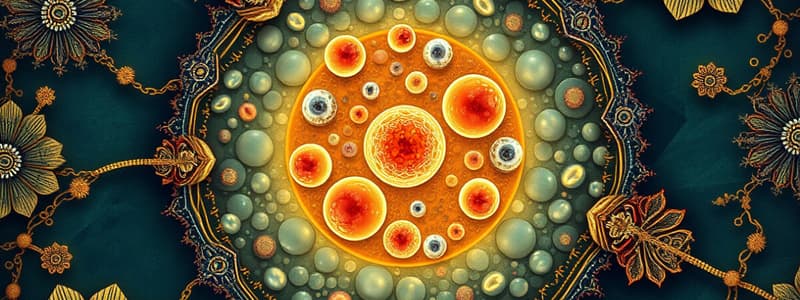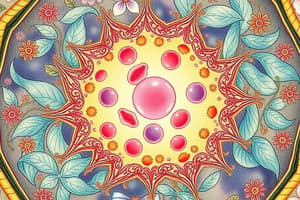Podcast
Questions and Answers
What component of a eukaryotic cell is responsible for producing energy?
What component of a eukaryotic cell is responsible for producing energy?
Which of the following correctly differentiates between prokaryotic and eukaryotic cells?
Which of the following correctly differentiates between prokaryotic and eukaryotic cells?
In an ecosystem, which group of organisms is responsible for breaking down dead material?
In an ecosystem, which group of organisms is responsible for breaking down dead material?
Which type of ecosystem is characterized by high rainfall and diverse plant and animal life?
Which type of ecosystem is characterized by high rainfall and diverse plant and animal life?
Signup and view all the answers
What is the main function of ribosomes in a cell?
What is the main function of ribosomes in a cell?
Signup and view all the answers
Which component of the human circulatory system is primarily responsible for transporting oxygen?
Which component of the human circulatory system is primarily responsible for transporting oxygen?
Signup and view all the answers
Which of the following is a characteristic of the smooth endoplasmic reticulum?
Which of the following is a characteristic of the smooth endoplasmic reticulum?
Signup and view all the answers
What role do producers play in an ecosystem?
What role do producers play in an ecosystem?
Signup and view all the answers
Study Notes
Cell Structure
- Basic Unit of Life: Cells are the fundamental units of life.
-
Types of Cells:
- Prokaryotic: Simple cells without a nucleus (e.g., bacteria).
- Eukaryotic: Complex cells with a nucleus (e.g., plant and animal cells).
-
Cell Organelles:
- Nucleus: Control center containing DNA.
- Mitochondria: Powerhouse of the cell; produces energy (ATP).
- Ribosomes: Sites of protein synthesis.
-
Endoplasmic Reticulum (ER):
- Rough ER: Studded with ribosomes; involved in protein synthesis.
- Smooth ER: Lacks ribosomes; involved in lipid synthesis.
- Golgi Apparatus: Modifies, sorts, and packages proteins and lipids.
- Cell Membrane: Protective barrier that regulates what enters and exits the cell.
- Chloroplasts: Present in plant cells; site of photosynthesis.
- Cell Wall: Rigid outer layer in plant cells for support and protection.
Ecosystems
- Definition: A biological community of interacting organisms and their physical environment.
-
Components of Ecosystems:
- Biotic Factors: Living components (plants, animals, microbes).
- Abiotic Factors: Non-living components (water, soil, climate).
-
Energy Flow:
- Producers: Organisms that create their own food (e.g., plants through photosynthesis).
- Consumers: Organisms that eat other organisms (herbivores, carnivores, omnivores).
- Decomposers: Organisms that break down dead material (fungi, bacteria).
-
Food Chain and Food Web:
- Food Chain: A linear sequence of organisms through which nutrients and energy pass.
- Food Web: A complex network of interconnected food chains.
- Biomes: Large regions characterized by specific climate and ecosystems (e.g., forests, deserts, tundras).
Human Body Systems
-
Major Body Systems:
- Circulatory System: Transports blood, nutrients, gases, and waste. Key components: heart, blood, blood vessels.
- Respiratory System: Facilitates gas exchange (oxygen and carbon dioxide). Key components: lungs, trachea.
- Digestive System: Breaks down food for energy and nutrients. Key components: mouth, stomach, intestines.
- Musculoskeletal System: Provides structure and movement. Key components: bones, muscles, joints.
- Nervous System: Controls body functions and responses. Key components: brain, spinal cord, nerves.
- Endocrine System: Regulates bodily functions through hormones. Key components: glands (e.g., thyroid, adrenal).
- Immune System: Defends against pathogens. Key components: white blood cells, lymph nodes.
- Integumentary System: Protects the body; includes skin, hair, nails.
-
Homeostasis: The process by which the body maintains a stable internal environment despite external changes.
Cell Structure
- Cells serve as the fundamental unit of life, forming the building blocks of all organisms.
- Prokaryotic cells are simple and lack a nucleus, exemplified by bacteria.
- Eukaryotic cells are more complex, contain a nucleus, and include plant and animal cells.
- The nucleus acts as the control center of the cell, housing genetic material (DNA).
- Mitochondria are known as the powerhouse of the cell, responsible for producing energy in the form of ATP.
- Ribosomes are the sites where protein synthesis occurs, translating mRNA into proteins.
- The endoplasmic reticulum (ER) has two forms:
- Rough ER is studded with ribosomes and plays a key role in protein synthesis.
- Smooth ER is devoid of ribosomes and synthesizes lipids.
- The Golgi apparatus modifies, sorts, and packages proteins and lipids for transport or secretion.
- The cell membrane serves as a protective barrier that regulates the movement of substances in and out of the cell.
- Chloroplasts are unique to plant cells and are the site of photosynthesis, converting sunlight into chemical energy.
- The cell wall provides structural support and protection in plant cells, giving them rigidity.
Ecosystems
- An ecosystem consists of a biological community of interacting organisms and their physical environment.
- Biotic factors include all living components, such as plants, animals, and microbes, while abiotic factors encompass non-living components like water, soil, and climate.
- Energy flow in ecosystems begins with producers, organisms that generate their own food, primarily through photosynthesis (e.g., plants).
- Consumers are classified as herbivores (plant-eaters), carnivores (meat-eaters), and omnivores (both plant and meat-eaters).
- Decomposers, such as fungi and bacteria, play a crucial role in breaking down dead material, recycling nutrients back into the ecosystem.
- The food chain is a linear sequence of organisms depicting how energy and nutrients flow, whereas the food web illustrates the complex interconnections among various food chains.
- Biomes represent large ecological areas characterized by distinct climate patterns and ecosystems, such as forests, deserts, and tundras.
Human Body Systems
- Major body systems include:
- Circulatory System: Responsible for transporting blood, nutrients, gases, and waste, with key components including the heart, blood, and blood vessels.
- Respiratory System: Facilitates gas exchange (oxygen and carbon dioxide) primarily through the lungs and trachea.
- Digestive System: Breaks down food into energy and nutrients, including structures like the mouth, stomach, and intestines.
- Musculoskeletal System: Provides structure and allows movement, comprising bones, muscles, and joints.
- Nervous System: Controls body functions and responses, with the brain, spinal cord, and nerves as primary components.
- Endocrine System: Regulates bodily functions through hormones produced by various glands, such as the thyroid and adrenal glands.
- Immune System: Protects the body against pathogens, relying on components like white blood cells and lymph nodes.
- Integumentary System: Acts as the body’s protective barrier, including skin, hair, and nails.
- Homeostasis refers to the body's ability to maintain a stable internal environment, even amidst external changes.
Studying That Suits You
Use AI to generate personalized quizzes and flashcards to suit your learning preferences.
Description
Test your knowledge on the fundamental units of life, cells, and their organelles, along with the basics of ecosystems. This quiz covers key concepts including prokaryotic and eukaryotic cells, as well as the functions of various cell structures. Challenge yourself and deepen your understanding of biology!




